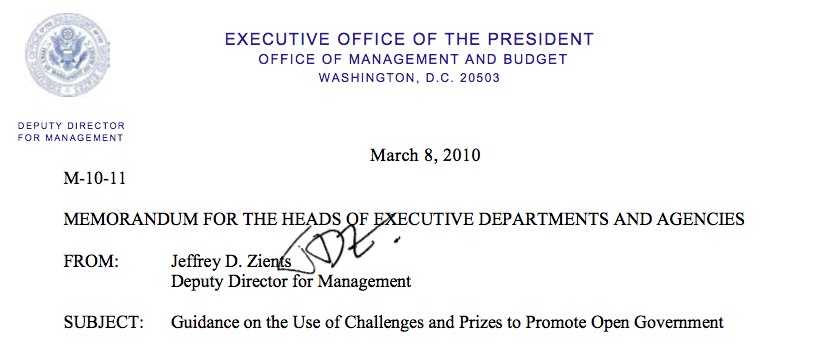While the French government has recently launched “Le Moteur de la Recherche” to increase collaboration between public and industrial research, President Barack Obama recently signed a memorandum that highlights issues related to the implementation of his Administration’s commitment to increase the use of prizes and challenges as tools for promoting open government, innovation, and other national priorities. This article is a summary of Obama’s memorandum.
Policy
Background
In September 2009, the Obama released his Strategy for American Innovation, calling for agencies to increase their ability to promote and harness innovation by using policy tools such as prizes and challenges.
Examples:
Potential Benefits of Prizes
Prizes and challenges have a number of potential benefits such as
- Establish an important goal without having to choose the approach or the team;
- Pay only for results;
- Increase the number and diversity of the individuals that are tacking a particular problem or challenge;
- Improve the skills of the participants in the competition.
To support agencies in the execution of prizes, Obama’s Administration will release sometime in June a web-based platform for prizes and challenges. This platform will provide a medium for agencies to post problems and invite communities of solvers to suggest, collaborate on, and deliver solutions.
Use of Prizes and Challenges
Choose the Right Prize for the Goal
There is a distinction between “recognition” prizes and “incentive” prizes. A recent study identified six types of prize. As a prize should not be an end in itself, agencies should select the type of prize best able to accomplish the broader aim:
- Exemplar prizes are prizes that recognize past general achievement in a field. Other types of prize may be more effectively to trigger future innovation.
- Point solution prizes aim to reward solutions for a particular well-defined problem. This type of prizes is well suited for online idea marketplaces.
- Exposition prizes help identify and promote a broad range of promising ideas and practices. An example is to encourage employees of a firm to propose creative ideas and reward the best ones.
- Network prizes build and strengthen networks and communities by organizing problem-solving communities that can deliver more impact than individual efforts.
- Participation prizes create value during and after the competition through their role in encouraging participants to change their behavior or develop new skills that may have beneficial effects during and beyond the competition.
- Market stimulation prizes try to establish the viability of a market to address a potential market failure.
Focus on All Stages of the Prize, including Pre-Prize and Post-Prize Stages
Agencies also should take care to plan for the post-prize phase, reinforcing the impact of an award with other investments and follow-up activities.
Choose the Right Vehicles and Partners for the Prize
Agencies should think broadly about the role that effective partners can play in administering or publicizing contests. It may be appropriate, where legally permissible, to seek Federal agency or non-federal partners to help meet agency goals.
Conclusions
Open Innovation is a global trend. One of the tools of Open Innovation is crowdsourcing (or prize or challenge) web-based platforms. Such platforms appeared in the United States over 10 years ago. Since then many variations appeared around the world. There is now a general tendency for governments to adopt such tools or to encourage the use of such tools. Which “Innovation 2.0 platform” will be the most efficient? Who will find first the winning solution?
Links and References
- McKinsey & Company, “And the winner is…”
- Memorandum



